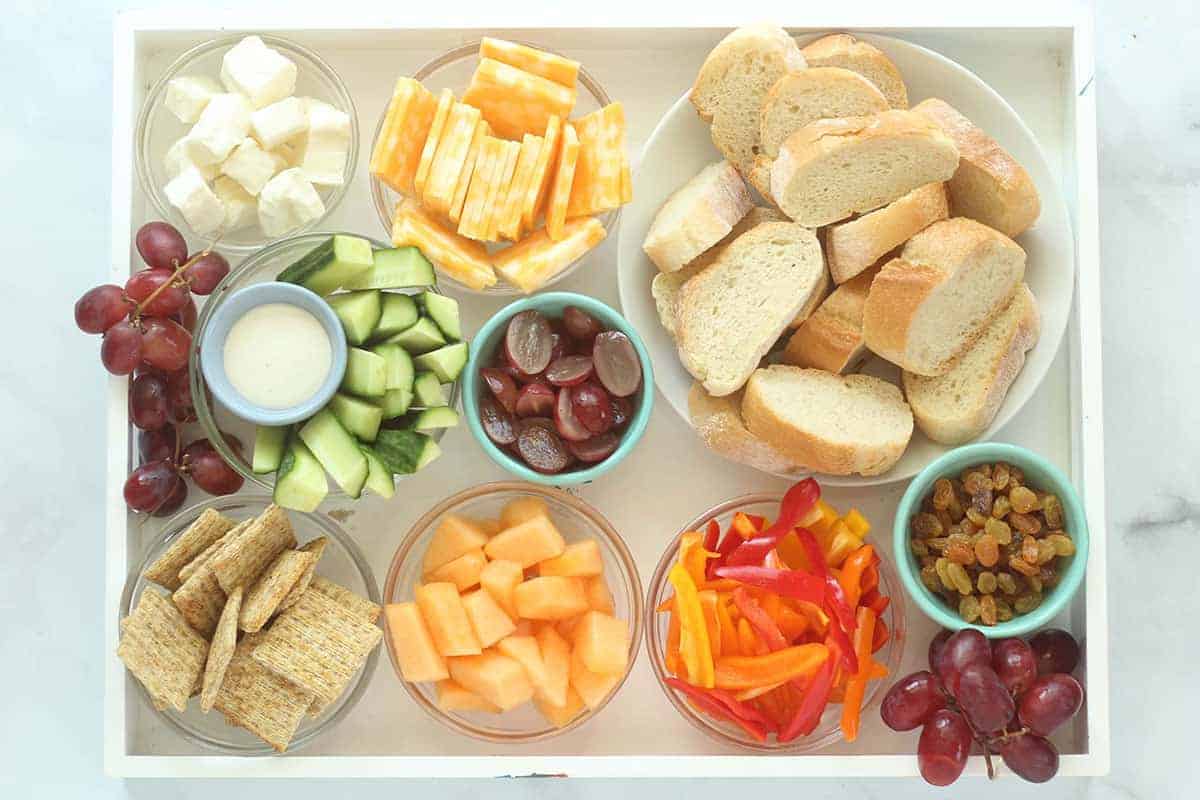What is intuitive eating? And how can it apply to how we feed ourselves and our kids? If you’re looking for a way to reduce drama around meals and improve your own relationship with what you eat and how you feel in your body, this is for you.

Intuitive Eating
We dive into the details of this topic with the original expert behind the method, Evelyn Tribole, MS, RD, who is the coauthor of the book Intuitive Eating. It was, and still is, the original guidebook for learning how to trust yourself around food. And as Evelyn says, “When you start to trust your own body, you start to trust other aspects of your life.”
Sign us up!
The Definition
There are 10 principles of Intuitive Eating that include: reject the diet mentality, honor your hunger, make peace with food, respect your fullness, and more. These really help to put the concept into context and give an idea of how the trust idea that Evelyn mentioned works with food and how we eat.
The main goal is to have a less fraught relationship with food, which when feeding kids can mean less bartering or bribing, less stress over each bite they take, and more confidence that the kids are going to be just fine even if they don’t eat everything we offer them. In short, it can help us all enjoy our meals—and our time together—more.
How it Works with Kids
There are some voices out there who say that kids can’t be trusted to eat what they need, but I strongly disagree. Babies are born knowing how to eat intuitively, baring any medical issues. It’s our job to help guard those instincts as they grow.
And if we set up the boundaries of when meals are served, what’s being offered, and where the meal is happening, we can give kids a lot of freedom to tap into their internal cues within that framework.
This is the essence of the Division of Responsibility—the job of the kids is to decide which foods and how much to eat, which is Intuitive Eating. And the reason we want them to have that consistent practice tuning in to their hunger and fullness is so they are able to do it without us when they’re out in the world as they grow. And so they don’t have to relearn how to listen to their bodies as they grow.
They’re born with these skills and we can help the kids maintain them, even when they start to hear diet messaging.

Intuitive Eating Tips for Busy Parents
Evelyn told us, “You have unconditional permission to eat. Ask yourself: Do I really want this? Do I like how it tastes and how it feels in my body?” This isn’t about willpower. We have more of a choice in how we eat than we may realize, especially once we can see past marketing, labels, and cultural expectations.
The more we can think of food marketing (and sometimes social media) as background noise, the more we can tune in to whether we actually want to be buying and eating certain foods based on how much we like them and how they make us feel.
(This is hard. I’m not saying it’s easy!)
Some tips to try:
- Challenge yourself to connect with the food you’re eating without distractions. So turn off the TV, put down the phone, put away the magazine, and sit with the family. This can be hard, especially with kids, but try to aim for one meal or snack a day where you can really pay attention to the food and the sensation of eating.
- We’ve been taught to fear food. When you have pleasure with your eating and are connected with the process, you’re more satisfied and it can be enjoyable. It’s okay to like food!
- As a parent, who often has so many competing demands on our attention during meals, here’s a simple tip: focus on the first, middle, and last bite if you’re too busy to focus on the whole thing. That’s a great place to start.
TIP: Evelyn’s latest edition of Intuitive Eating can help us adults understand this more too.

How to Implement it at Family Meals
All of this can sound fine in writing, but when you actually go to do it in real life with the kids, it can be a challenge. Use these tips below to help set you up to use this approach at meals with the kids—without additional stress.
1. Serve One Meal with Multiple Components
Tacos with the toppings on the side. Pasta served plain with sauce and toppings separate. Serve one meal in components so each person at the table can pick and choose what they’d like to eat. This is helpful since it allows both kids and adults to personalize their plates! Family-style meals are very helpful here.
2. Involve the Kids
Bring them to the store or out into the garden. Have them help prep something simple for dinner or choose a few meals throughout the week. Put one in charge of clean up duty and allow them to delegate to the other family members.
You can keep the involvement simple, but having them around and in the mix of food prep and procurement away from the table can inspire interest and curiosity about food with less pressure.
3. Introduce them to Diverse Food Experiences
Consider trying a new ethnic restaurant or making a new recipe together at home when you have time. Make food a fun experience—not just something they have to do before they go off to play/shower/do their homework. This gets more and more fun as the kids get older!
4. Make Sure Each Meal or Snack Includes 1-2 Foods They Usually Like
This acts as a safety net and gives the kids something to eat if they don’t like the main dish. Simple foods like cut up fresh fruit, bread, cheese, applesauce, or a favorite veggie can serve this role too.
5. Model Food Enjoyment
Surround the family with a diverse mix of foods. Model food enjoyment yourself by sitting down and enjoying your food. Show that it makes you happy to eat and share meals with them. If you can take the guilt and stress out of your own eating, it will be easier for them to have a healthy longterm relationship with food, too.
6. Be a Safe Place to Communicate Food Preferences
Maybe one of your kids loves guacamole and another can’t stand it. One likes to dip his tacos in ketchup, which makes you cringe. Remember that we all have unique preferences and it’s OKAY. Trust that the more your kids can tune into theirs, the better off they’ll be as they grow. And let them share them without judgement.
7. Avoid Short Order Cooking Whenever Possible
There’s nothing wrong with making the kids a separate meal if you want to, but you should never feel like you can’t do one family dinner. See Number 4 in this list for simple sides to surround the main dish. This approach teaches the value of sharing food as it allows for preferences.
8. Have Set Meal and Snack Times
This can help the kids have time to get hungry in between and it can help add a natural rhythm to your days. It’s always okay if the kids are hungry in between—we do want to be responsive to their hunger—but if you’re regularly having food every 2-3 hours, that likely won’t happen much, which can reduce stress in the moment.
9. Avoid Using Dessert as a Reward
Food rewards can be a little tricky to navigate, but the more you can avoid using “treat” foods as rewards for eating “regular” foods and just letting food be food, the less time you’ll spend negotiating bites of broccoli with your little people. (And unintentionally putting treat foods on a pedestal, making them more appealing than they already are.)
You still get to decide which foods to serve when, but after that, you can step back and let the kids decide what of it to eat. (Read more on this Division of Responsibility here.)
Frequently Asked Questions
“Sneaky behavior isn’t always isolated just to food, they could be at an age when these types of behaviors are becoming more and more common. This is worth noting whether it’s a food issue or if it’s “normal” developmental behavior,” explains Emily Fonnesbeck, RD Nutrition Therapist.
“If it’s mostly with food, you could explore if you’re being overly controlling with their responsibilities with food. While your responsibilities are for what, where, and when, the kids are responsible for what and how much. Do you let them eat as much as they want at meal and snack times? Structure and freedom are both important and you can’t have one without the other. If you allow them the freedom they need, they’re less likely to oppose the needed structure with food.”
“Let them have more choices at the store, and when it’s time for meals, involve them more so they feel like they have more involvement over their food choices and preferences. They’ll be less likely to sneak foods if their meals are satisfying and they have access to favorite foods. And if there’s not a power struggle where they feel like they need to prove something,” Emily says.
“All kids are different. Some kids never think about food and others think about food all the time. Some kids are indifferent to food, some kids love it. Some kids are shy, some are outgoing, some are short All are normal. There’s no one right way to be with food.” Emily says.
“Instead of looking at her feelings about food as wrong, try to see her approach to food and her feelings as part of her unique personality,” she continues. “You’ll be able to support her in competent eating without trying to change her. Consider asking: What does fullness feel like to you? What does hunger feel like to you?
How does your body communicate to you that it needs food?”
“Instead of telling her that she’s doing something wrong, the goal would be to guide her back to her body to make respectful decisions about food.” —Emily
You could look at the environment in which kids are eating to see if there’s something that’s getting in the way of her being in touch with her hunger cues. Is she watching a screen? Is she reading? And remember: It is sometimes okay to eat food just because it tastes good.
“Even if you serve a lot of veggies and they see you eating them too, your kids will likely still prefer other foods. It’s totally normal,” Emily explains.
“Your job is to provide balance, not to force them to eat in balanced ways.”
“We’ve got to take the long view here. Raising competent eaters is a longterm goal. The goal is help them develop healthy views on food and their body including body autonomy. By not forcing them and instead sending an example of well rounded, flexible and nonjudgemental nutrition, they will learn one meal at a time what a balanced meal looks like so when they are ready to go out on their own, they’ll be ready to feed themselves well without fear or judgement or needing someone else to tell them how to do it,” she says.
It might help to make a physical list of the foods your kids are enjoying. They may actually eat more foods than you think they do!
“You could start by moving the food out of her reach and out of sight. At her age, she probably does still need structure, but you could consider leaving out some fruit (like bananas on the counter) that you don’t mind her helping herself to. And make sure that she’s getting to focus on eating and getting her fill at meal and snack time,” Emily recommends.
Another thing that may help is to give two choices come meal or snack time to help her feel like she’s getting the food that she wants. So ask, “would you like to have yogurt or cheese today with snack?”. And consider serving “snack foods” at meal times so she knows they aren’t too off limits.
I’d also recommend that you consider what you have in your house and if there are certain things that triggers your emotional reaction, don’t make it an option.
You can download this episode from iTunes, Stitcher, Google Play, TuneIn Radio, or wherever else you get your podcasts. or listen to it here!
I’d love to hear your feedback on this post, so comment below to share!
This post was originally published May 2019.























I am so glad I found you! I started reading Intuitive Eating recently, and feel it’s just what I need. I’ve had a terrible relationship with food as long (or longer!) than I can remember. For one thing, I’ve always had major texture issues with food, and I now know I have ADHD, which is a contributing factor. I know my mom and dad did the best they could and wanted me to be healthy. Unfortunately, they didn’t know how to help me achieve that. So many bad memories of being yelled at and made to sit at the table for hours staring at a pile of cold, mushy peas! I’ve been thinking recently, “What would I have liked my parents to do differently? How can I do that for myself now?” I think your posts will really help me “re-parent” myself and create healthier, happier eating habits. Thank you!
You’re so welcome, thank you for sharing that!
Its a great pleasure reading your post. Its full of information I am looking for and I love to post a comment that “The content of your post is awesome” Great work 😉